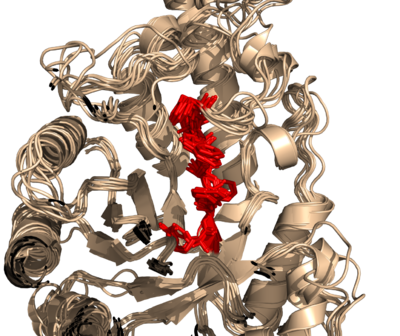Findseq
Jump to navigation
Jump to search
The printable version is no longer supported and may have rendering errors. Please update your browser bookmarks and please use the default browser print function instead.
Overview & Motivation
Anyone ever give you a protein and then say, find the sequence "FLVEW"? Well, this script will find any string or regular expression in a given object and return that selection for you. Here's an example,
# fetch two sugar-binding PDB
fetch 1tvn
# Now, find FATEW in 1tvn, similarly
findSeq FATEW, 1tvn
# lower-case works, too
findSeq fatew, 1tvn
# how about a regular expression?
findSeq F.*W, 1tvn
# Find the regular expression:
# ..H[TA]LVWH
# in the few proteins loaded.
# I then showed them as sticks and colored them to highlight matched AAs
for x in cmd.get_names(): seqFinder( "..H[TA]LVWH", x, "sele_"+x, firstOnly=1 )
Usage
I built this to be rather flexible. You call it as:
findSeq needle, haystack[, selName[, het[, firstOnly ]]]
where the options are:
- needle the sequence of amino acids to find. Should be a string of one letter amino acid abbreviations. Can also be a string-style regular expression (eg. FW.*QQ).
- haystack the PyMOL object or selection in which to search
- selName the name of the returned selection. If you leave this blank, it'll be foundSeqXYZ where XYZ is some random integer (eg. foundSeq1435); if you supply sele then the usual PyMOL (sele) is used; and, finally, if it's anything else, then that will be used verbatim. Defaults to foundSeqXYZ so as not to overwrite any selections you might have in sele.
- het 0/1 -- if 0 then heteroatoms are not considered; if 1 then they are; defaults to 0
- firstOnly 0/1 -- if 0 then all matches are selected and returned; if 1 then only the first is returned
The Code
# -*- coding: utf-8 -*-
#
# -- seqFinder.py
#
# Finds given amino acids in a protein & returns the selection.
#
#
import re
import types
import random
import pymol
from pymol import stored
def checkParams(needle,haystack,selName,het,firstOnly):
"""
This is just a helper function for checking the user input
"""
# check Needle
if len(needle)==0 or type(needle)!=types.StringType:
print "Error: Please provide a string 'needle' to search for."
print "Error: For help type 'help motifFinder'."
return False
# check Haystack
if len(haystack)==0 or type(haystack)!=types.StringType:
print "Error: Please provide valid PyMOL object or selection name"
print "Error: in which to search."
print "Error: For help type 'help motifFinder'."
return False
# check het
try:
het = bool(int(het))
except ValueError:
print "Error: The 'het' parameter was not 0 or 1."
return False
# check first Only
try:
firstOnly = bool(int(het))
except ValueError:
print "Error: The 'firstOnly' parameter was not 0 or 1."
return False
# check selName
if type(selName)!=types.StringType:
print "Error: selName was not a string."
return False
return True
def seqFinder(needle, haystack, selName=None, het=0, firstOnly=0):
"""
DESCRIPTION:
Given a sequence/regex to find, select those
matching amino acids in the protein.
USAGE:
seqFinder needle, haystack[, selName[, het[, firstOnly]]]
PARAMS:
needle (string)
the sequence of amino acids to match and select
in the haystack. This can be a sequence of amino
acids, or a string-style regular expression. See
examples.
hastack (string or PyMOL selection)
name of the PyMOL object/selection in which
to find the needle.
selName (string; defaults to None)
This is the name of the selection to return. If selName
is left blank (None), then the selection name will be
foundSeqXYZ where XYZ is some random number; if selName is
"sele" the usual PyMOL "(sele)" will be used; and, lastly,
if selName is anything else, that name will be used verbatim.
het (0 or 1; defaults to 0)
This boolean flag allows (1) or disallows (0) heteroatoms
from being considered.
firstOnly (0 or 1; defaults to 0)
Subsequences or motifs might be repeated, this controls how we
consider multiple matches. If firstOnly is False (0) then we return
all found subsequences; if firstOnly is True (1), then we just return
the first found sequence.
RETURNS:
a newly created selection with the atoms you sought. If there are
more than two contiguous regions, then a newly created group is
returned with each contiguous segment its own selection.
EXAMPLE:
# find SPVI in 1h12, foundSeqXYZ as return name
seqFinder SPVI, 1h12
# find FATEW and make it (sele).
seqFinder FATEW, 1g01, sele
# find the regular expression GMS.*QWY in 1a3h
# and put the return value in (sele).
fetch 1a3h
# this ends up finding the sequence, GMSSHGLQWY
seqFinder GMS.*QWY, 1a3h, sele
NOTES:
Assumes we're using the ONE LETTER amino acid abbreviations.
AUTHOR:
Jason Vertrees, 2009.
"""
# input checking
if not checkParams(needle, haystack, selName, het, firstOnly):
print "There was an error with a parameter. Please see"
print "the above error message for how to fix it."
return None
one_letter ={'VAL':'V', 'ILE':'I', 'LEU':'L', 'GLU':'E', 'GLN':'Q', \
'ASP':'D', 'ASN':'N', 'HIS':'H', 'TRP':'W', 'PHE':'F', 'TYR':'Y', \
'ARG':'R', 'LYS':'K', 'SER':'S', 'THR':'T', 'MET':'M', 'ALA':'A', \
'GLY':'G', 'PRO':'P', 'CYS':'C'}
# remove hetero atoms (waters/ligands/etc) from consideration?
if het:
cmd.select( "__h", "br. " + haystack )
else:
cmd.select( "__h", "br. " + haystack + " and not het" )
# get the AAs in the haystack
aaDict = { 'aaList' : [] }
cmd.iterate("(name ca) and __h","aaList.append((resi,resn))",space=aaDict)
IDs = map( lambda x: int(x[0]), aaDict['aaList'] )
AAs = ''.join(map( lambda x: one_letter[x[1]], aaDict['aaList'] ))
reNeedle = re.compile( needle.upper() )
it = reNeedle.finditer( AAs )
# set the name of the selection to return.
if selName == None:
rSelName = "foundSeq" + str(random.randint(0,32000))
elif selName == "sele":
rSelName = "sele"
else:
rSelName = selName
# make an empty selection to which we add residues
cmd.select( rSelName, 'None')
for i in it:
(start,stop) = i.span()
cmd.select( rSelName, rSelName + " __h and i. " + str(IDs[start]) + "-" + str(IDs[stop-1]))
if int(firstOnly):
break
cmd.delete("__h")
return rSelName
cmd.extend("seqFinder", seqFinder )
